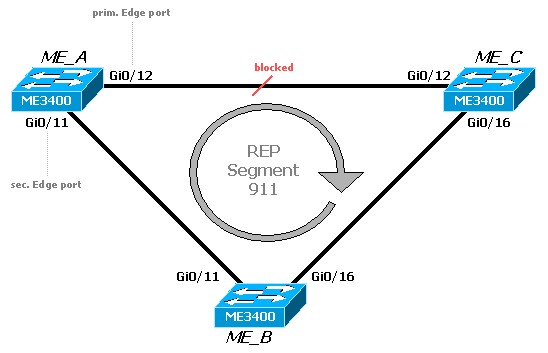Configuring Resilient Ethernet Protocol
Resilient Ethernet Protocol (REP) is a Cisco propietary protocol which allows you to build redundant Ethernet rings. It’s an alternative to Spanning-Tree protocol and also avoids bridging loops or responds to link failures.
Compared to STP, it offers a faster convergence time (< 300ms) and gives you a simple VLAN load-balancing method.
In our example, we interconnect three switches (Cisco ME3400 with me340x-metroaccess-mz.122-50.SE1.bin) to a ring topology. In REP terminology, this is called a segment.
A REP segment is a chain of ports connected to each other and configured with a segment ID. Each segment consists of standard (nonedge) segment ports and two user-configured edge ports. A switch can have only two ports belonging to the same segment, and each segment port can have only one external neighbor.
I decided to configure the two edge ports on switch ME_A. Ports on ME_B and ME_C are configured as standard segment ports.
You can also examine the REP status of a particular interface with “show int <interface> rep [detail]“
Cisco Rep
source:http://www.net-gyver.com
Compared to STP, it offers a faster convergence time (< 300ms) and gives you a simple VLAN load-balancing method.
In our example, we interconnect three switches (Cisco ME3400 with me340x-metroaccess-mz.122-50.SE1.bin) to a ring topology. In REP terminology, this is called a segment.
A REP segment is a chain of ports connected to each other and configured with a segment ID. Each segment consists of standard (nonedge) segment ports and two user-configured edge ports. A switch can have only two ports belonging to the same segment, and each segment port can have only one external neighbor.

REP segments have the following characteristics:
- When all ports in a segment are operational, one port (referred to as the alternate port) is in the blocked state for each VLAN.
- If VLAN load balancing is configured, two ports in the segment control the blocked state of VLANs.
- If one or more ports in a segment is not operational, causing a link failure, all ports forward traffic on all VLANs to ensure connectivity.
- In case of a link failure, the alternate ports are unblocked as quickly as possible. When the failed link comes back up, a logically blocked port per VLAN is selected with minimal disruption to the network.
- A port configured as a regular segment port starts as a failed port.
- After the neighbor adjacencies are determined, the port changes to alternate port state, blocking all VLANs on the interface. Blocked port negotiations occur and when the segment settles, one blocked port remains in the alternate role, and all other ports become open ports.
- When a failure occurs in a link, all ports move to the open state. When the alternate port receives the failure notification, it changes to the open state, forwarding all VLANs.
Simple Configuration without VLAN load-balancing
First, we configure all ring interfaces as REP ports with segment ID 911. All interface have to be Layer 2 trunk interfaces. To get REP working, we have to configure at least on edge port. For VLAN load-balancing, two edge ports are necessary.I decided to configure the two edge ports on switch ME_A. Ports on ME_B and ME_C are configured as standard segment ports.
Activating REP produces a log message and you can examine the topology with “show rep topology” on switch ME_C:ME_A: interface GigabitEthernet0/11 description Trunk to ME_B port-type nni switchport mode trunk rep segment 911 edge primary interface GigabitEthernet0/12 description Trunk to ME_C port-type nni switchport mode trunk rep segment 911 edge ME_B: interface GigabitEthernet0/11 description Trunk to ME_A port-type nni switchport mode trunk rep segment 911 interface GigabitEthernet0/16 description Trunk to ME_C port-type nni switchport mode trunk rep segment 911 ME_C: interface GigabitEthernet0/12 description Trunk to ME_A port-type nni switchport mode trunk rep segment 911 interface GigabitEthernet0/16 description Trunk to ME_B port-type nni switchport mode trunk rep segment 911
ME_C#sh rep topology
REP Segment 911
BridgeName PortName Edge Role
---------------- ---------- ---- ----
ME_A Gi0/11 Pri Open
ME_B Gi0/11 Open
ME_B Gi0/16 Open
ME_C Gi0/16 Open
ME_C Gi0/12 Open
ME_A Gi0/12 Sec AltYou can also examine the REP status of a particular interface with “show int <interface> rep [detail]“
I case of a link failure on Gi0/16 between ME_B and ME_C , you will see the following syslog message:ME_C#sh int g0/12 rep Interface Seg-id Type LinkOp Role ---------------------- ------ --------------- ----------- ---- GigabitEthernet0/12 911 TWO_WAY Open ME_C#sh int g0/12 rep det GigabitEthernet0/12 REP enabled Segment-id: 911 (Segment) PortID: 000C0024F7C1FE00 Preferred flag: No Operational Link Status: TWO_WAY Current Key: 00100024F7C1FE0070BB Port Role: Open Blocked VLAN: <empty> Admin-vlan: 1 Preempt Delay Timer: disabled LSL Ageout Timer: 5000 ms Configured Load-balancing Block Port: none Configured Load-balancing Block VLAN: none STCN Propagate to: none LSL PDU rx: 11400, tx: 7422 HFL PDU rx: 0, tx: 0 BPA TLV rx: 8680, tx: 860 BPA (STCN, LSL) TLV rx: 0, tx: 0 BPA (STCN, HFL) TLV rx: 0, tx: 0 EPA-ELECTION TLV rx: 148, tx: 19 EPA-COMMAND TLV rx: 0, tx: 0 EPA-INFO TLV rx: 2197, tx: 2202
REP converges immediately and unblocks the “Alt”-Link. Gi0/16 changes to “fail -state*Mar 1 07:03:17.617: %REP-4-LINKSTATUS: GigabitEthernet0/16 (segment 911) is non-operational due to port become non-trunk
(All informations taken from Cisco Website)ME_C#sh rep topology REP Segment 911 Warning: REP detects a segment failure, topology may be incomplete BridgeName PortName Edge Role ---------------- ---------- ---- ---- ME_C Gi0/16 Fail ME_C Gi0/12 Open ME_A Gi0/12 Sec Open
Cisco Rep
source:http://www.net-gyver.com
No comments:
Post a Comment